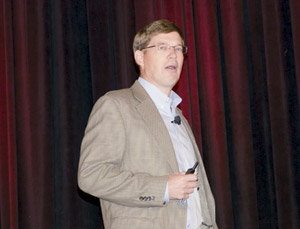Market Still Positive
Despite challenges, overall, CattleFax outlook is optimistic.

"Based on Omaha corn prices, the lack of rain and intense heat will keep corn prices in the $6.50-$8.00 range for the foreseeable future," noted Kevin Good, senior market analyst for CattleFax.
DENVER, Colo. (July 27, 2012) — The drought last year was devastating, but the drought this year has hit the Corn Belt and is more widespread, affecting even more people, says Kevin Good, senior market analyst for CattleFax. Obstacles abound this year, he told participants of the second general session at the 2012 Cattle Industry Summer Conference in Denver, Colo., July 25-28.
Last year 65% of the country was in moderate drought. This year, that has increased to 70%, and the extreme to exceptional drought percentage is up to 27%, Good said. With 70% of the U.S. cattle inventory located in regions of drought, beef producers are trying to salvage and allocate their resources.
Citing CattleFax meteorologist Art Douglas, Good said the El Niño weather pattern is bringing the southern third of the country more rain, but not enough to save the corn and pasture for the remainder of this growing season. Pastures are already at the worst level in the last 15 years, with growing conditions for the rest of the summer remaining to be seen.
This year, cattle-on-feed inventories have risen about 3% in feedyards with capacities greater than 1,000 head, though marketing is still down about 2%-4%. Feedyards with capacities less than 1,000 head are reporting lower inventories due to higher corn prices. Good predicted the smaller farmer-feeder operations would bypass feeding cattle this year and just sell the corn.
“Based on Omaha corn prices, the lack of rain and intense heat will keep corn prices in the $6.50-$8.00 range for the foreseeable future,” noted Good.
Because their diet is a higher percentage of corn, the higher corn prices are affecting the pork and poultry industries more than the beef industry, which means there will be less supply of competing proteins. All three proteins are exporting more, and with higher input costs causing lower supplies, price in the export market has gone up.
Exports have still been on the rise (at a lower rate), Good said, but so have imports. The dollar has strengthened, and the lean, finely textured beef (LFTB) issue has created need to import more lean trim.
The beef cow herd inventory is still declining, down another half million this year, and the drought is affecting the rate of liquidation, Good explained.
“The U.S. calf crop is down 800,000 head,” he said. “Bottom line, when all is said and done, the cattle herd will decrease by about 500,000 head. This is compared to a 900,000 decrease a year ago. So, we are seeing a liquidation, but at a slower pace than last year.”
If Mother Nature cooperates, the liquidation should slow next year, he said, and expansion could begin within a couple of years. This means that production is tighter, and prices are supported because of the reduced supply.
Despite the obvious challenges facing America’s cattlemen and women, Good offered reason for optimism. Wholesale beef demand has gone up 5% from last year. Prices have gone up from recession years, there is better foodservice business and there is more retail exposure. Retailers have kept middle cuts at high prices and have widened the Choice-Select spread. Restaurant performance is in an expansion phase, though that has slowed slightly in May and June.
Prices are extremely friendly for beef and other proteins, Good noted, citing as an example the $80-per-hundredweight (cwt.) average price for utility cows, feeder-calf prices at $188 per cwt., and yearling prices at $168 per cwt..
“I know with the drought, it seems pretty rough, but if you stand back and look at the longer view, we can be optimistic of where we’re going in the next few years,” he posits.
To read other summaries from this conference, click here.
-----------------------------
Editor’s Note: The above article was written under contract or by staff of Angus Productions Inc. It may not be reprinted without express permission of API. To request reprint permision, contact the editor at 816-383-5200.
The API Virtual Library is provided as a resource to cattlemen by the editorial team at Angus Productions Inc. (API), publisher of the Angus Journal, the Angus Beef Bulletin, the Angus Beef Bulletin EXTRA and the Angus e-List. For questions about this site, to submit an article for our consideration, or to report a broken link, contact the editor at 816-383-5200; 3201 Frederick Ave., Saint Joseph, MO 64506.
API claims copyright to this website as presented. We welcome educational venues and cattlemen to link to this site as a service to their audience.






